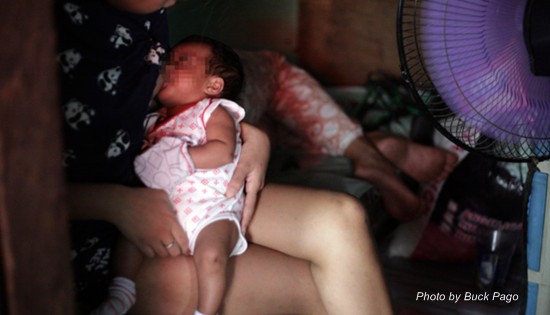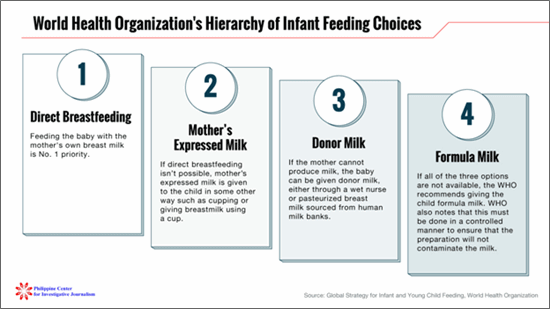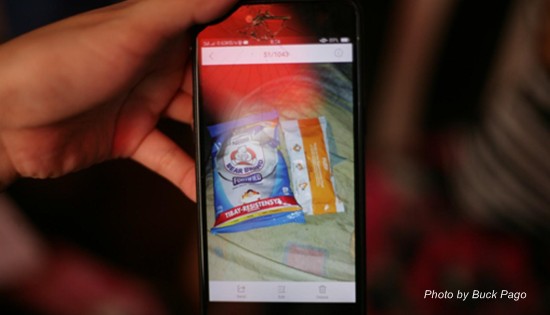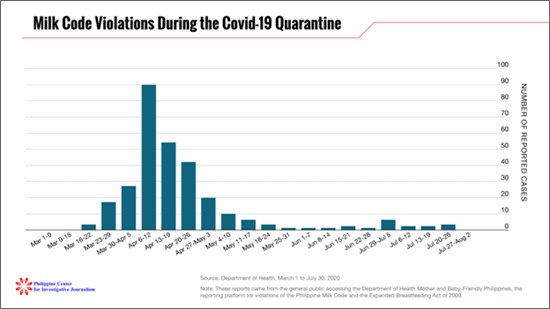|

Hazel
breastfeeds her child, two-month old Pia, not their real
names, inside their house in Barangay Inarawan, Antipolo
City. Hazel's mother, Maryjoy Mota, posted several
comments on social media asking for help in buying
formula milk for her infant grandchild after the
enhanced community quarantine (ECQ) was enforced in
March. The family's breadwinner, Ricky, lost his job as
a construction worker when the ECQ began. Hazel and her
boyfriend are teenage students with no jobs. With little
money to buy formula milk for Pia, Maryjoy encouraged
Hazel to breastfeed her infant daughter. |
Milk and the
pandemic: Milk Code confusion cripples LGUs response for infants
By
ANGELICA CARBALLO PAGO
Philippine Center for Investigative Journalism
October 8, 2020
The
indiscriminate distribution and use of breastmilk substitutes,
especially during emergencies, can change feeding practices and put
babies at greater risk of illness.
What you need to know
about this story:
- Experts are calling for
measures to ensure the health and safety of infant and young
children, which can easily be undermined by the milk industry’s
aggressive marketing initiatives.
- The Milk Code does not
ban formula milk procurement and distribution by local government
units, provided they follow guidelines set by the Department of
Health (DOH).
- Marketing and
advertising of products within the scope of the Milk Code, however,
are prohibited. Donations of formula milk and breastfeeding
substitutes from manufacturers and distributors of these products
are banned.
- Local government units
are clueless to the finer details of breastfeeding and infant and
young child nutrition laws, to the detriment of mothers, infants and
young children in need especially during the current Covid-19
crisis.
- Milk companies use
disasters and crises to market their products, and DOH data show a
rise in Milk Code violations during the enhanced community
quarantine period.
Here’s one unintended
consequence of the Covid-19 health emergency: Parents and guardians
are desperately finding ways to feed their babies, with some even
begging on the streets or on social media. With lockdowns making it
harder to provide proper and adequate food for the family, their
health and nutrition -- especially of babies -- are at risk.
Local governments
attempted to solve the problem by distributing formula milk to
mothers, only to find out that donations are not allowed by the Milk
Code, a 1986 law regulating the marketing and distribution of
breastmilk substitutes.
Worse, formula milk makers
seem to be taking advantage of the situation to undermine strict
government regulations, experts observed.
During the Enhanced
Community Quarantine (ECQ) in March, Maryjoy Mota, a 37-year-old
resident of Antipolo, posted on the Antipolo City Facebook group
that her two-month-old granddaughter needed diapers and formula
milk.
Maryjoy’s daughter,
17-year-old Hazel, had just given birth to Pia (not their real
names), two weeks before the ECQ was enforced throughout Luzon in
mid-March. Maryjoy’s post drew a hundred other comments from mothers
and guardians in the same situation.
With Hazel giving birth to
Pia two weeks ahead of her due date, the doctor immediately
prescribed a formula milk brand, PreNan, developed for premature
newborns. Weighing just 1.7 kilograms, the baby had to be placed in
an incubator.
“We were not given any
other options or brands, nor given any instructions or assistance to
start breastfeeding,” Maryjoy said.
Even when Hazel went for check-ups at the barangay and the district
health centers before she gave birth, there were no instructions on
breastfeeding, which could have helped them save some money instead
of spending it on formula milk, she said.
Sought for comment, an official of the Rizal Provincial Hospital
System - Antipolo Annex 1, who asked not to be named, insisted that
the hospital followed breastfeeding protocols. But Pia weighed below
the 2.5-kilogram birth weight threshold and showed signs of sepsis,
the official said.
The formula milk prescribed to Pia met the baby’s caloric
requirements, which might not be sustained by breastfeeding, the
official said.
But with no income, it was
impossible to buy the 400-gram can of milk, which costs P641.
Maryjoy’s common-law husband, Ricky, lost his construction job
because of the pandemic, while Pia’s parents were unemployed
teenagers.
While some local leaders
were aware of the plight of new mothers like Hazel, the Milk Code
posed an obstacle. Sangguniang Kabataan Chairman Arky Manning of
Barangay San Isidro in Taytay, Rizal learned this the hard way.
The Department of Health (DOH)
gave Manning a memo for violating Executive Order (EO) 51, or the
Milk Code of 1986, by “accepting and distributing milk formula
donations” given to mothers with infants in Taytay in April and May
2020.
Manning explained that it
was part of the “Tulong Kay Baby” (help for baby) project, a
donation drive that he had organized with his friends. They bought
milk and diapers using funds given by private individuals. No mass
distribution or random donation of milk happened, he claimed.
Manning was one of the 291
violators flagged by the DOH from March 1 to July 24, largely
covering the ECQ period in Luzon. Reports of violations came from
the general public, submitted through http://mbfp.doh.gov.ph. MBFP,
which stands for DOH’s Mother and Baby-Friendly Philippines, is the
reporting platform for violations of the Milk Code and the Expanded
Breastfeeding Act of 2009 (Republic Act 10028).
The list of violators
included health workers, non-profit organizations, and local
executives such as Manning, and Mayors Andrea Henares of Antipolo
City and Marcy Teodoro of Marikina City. Also on the list were
celebrities such as Say Alonzo and Marian Rivera Dantes, who
together with Nido, a brand that Dantes endorses, and the YesPinoy
Foundation, were reported to have distributed follow-on formula.
Dantes even posted it on Instagram to her 9.4 million followers.
EO 51 issued by former
President Corazon C. Aquino, otherwise known as the Philippine Milk
Code of 1986 or simply, the Milk Code, regulates the marketing of
breastmilk substitutes, including milk formula, breastmilk
supplements and other similar products by prohibiting the
advertising and promotion, whether written, audio or visual, for
such products. It adheres to the International Code on Marketing of
Breastmilk Substitutes, adopted by the World Health Assembly in May
1981. Breastfeeding advocates have hailed the Milk Code as one of
the strongest breastfeeding protection laws in the world.
The Milk Code’s Revised
Implementing Rules and Regulations (RIRR), released 30 years after
the law was signed, prohibits the donation of infant formula and
breastmilk. Administrative orders from the DOH and the Department of
the Interior and Local Government (DILG) further disallow the
donation of infant formula milk and breastmilk substitutes in times
of disasters and calamities.
According to data from the
Food and Nutrition Research Institute, exclusive breastfeeding rates
have continuously gone up in the last 10 years, reaching 57.9
percent in 2019. The global exclusive breastfeeding rate stands at
41 percent. The United Nations targets to increase global
breastfeeding rates to 50 percent by 2025.
Marketing is prohibited, the milk is not
Health Undersecretary
Maria Rosario Vergeire said the law did not bar local government
units (LGUs) from procuring formula milk.
“If local government units
procure formula milk, the law does not cover it. EO 51 is a
regulatory tool used by the Department of Health to regulate the
advertisement of manufacturers that formula milk is more important
than a mother’s milk. That’s our first objective -- we would like to
know that breastmilk is still the best for babies,” she said.
DOH Memorandum No.
2020-0231, dated May 15, 2020, laid down the guidelines on the
standardized regulation of donations covered by the Milk Code.
Formula milk and breastmilk substitutes can still be provided to
those in need, with the following conditions:
1. The local government
unit buys it using its own budget (procurement);
2. Breastmilk should still
be the first choice and the procured formula milk is given to
identified mothers/infants, not distributed en masse;
3. Distribution,
preparation and use of breastmilk substitute and formula milk must
be done under the supervision of health and nutrition workers;
4. There should be no
brand name, logo or identifiable marks of the manufacturer; and
5. No public relations,
announcement or the likes may occur.
Dr. Mianne Silvestre,
executive director of Kalusugan ng Mag-Ina (mother’s health)
Foundation, echoed Vergeire’s explanation.
“The Milk Code is there to
regulate the marketing and advertising of formula milk and
breastfeeding substitutes, and not to penalize parents who give
these products to their children,” Silvestre said. “Nobody goes to
jail for feeding formula milk to their babies.”
Sharing a similar view,
Dr. Paul Zambrano, a technical specialist at Alive and Thrive, a
private initiative to reduce child undernutrition by improving
infant and young child feeding practices, said: “Marketing (of
formula milk and breastmilk substitutes) will undermine the practice
of breastfeeding and complementary feeding with healthy food after
six months. It’s meant to save lives. It is meant to prevent the top
killers of children in that age group – diarrhea and pneumonia. ”
The problem, Silvestre
said, was that formula milk was being marketed as the first option
instead of breastfeeding. This goes against the hierarchy of infant
feeding choices laid out in the Global Strategy for Infant and Young
Child Feeding published by the World Health Organization (WHO),
which states that donated breast milk from a wet nurse or milk bank
takes precedence over formula milk.

Even for Covid-19 positive
mothers, the WHO still recommends continued breastfeeding and
rooming of babies with their mothers. Transmission of Covid-19
through breastmilk or breastfeeding has not been established.
No guidance for LGUs
What can and cannot be
done under the code does not seem to be clear to local governments,
even to the DILG. In an interview with PCIJ, Interior Undersecretary
Jonathan Malaya, affirmed that the ban extends to selective
distribution of milk to identified mothers and babies and referred
to the National Nutrition Council website for guiding policies.
Taytay’s Manning said no
guidance came from any government agency, particularly the DOH or
DILG, on how they could respond to the needs of mothers and their
babies.
During the quarantine,
local officials, such as Quezon City Councilor Ariel Inton,
repeatedly appealed to the DOH to lift the ban on milk donations.
In a Facebook livestream,
Inton, a lawyer, gave practical advice to barangay officials
planning to distribute formula milk to their constituents. “Tell
them that you are handing it out as loans or ask for coins so they
won’t say it’s a donation, so you can give the children something to
eat,” Inton said.
For Ynares, while the Milk
Code has an important purpose, it can also be a “bane during
crisis.”
“It poses a huge challenge
for families and the government to provide essential nutrition
required for child growth and development particularly during
extraordinary times,” the Antipolo City mayor said.
A National Nutrition
Council advisory said that LGUs should consider that some recipients
of pandemic relief goods have young children and pregnant and
lactating mothers. Families are supposed to be monitored by Barangay
Nutrition Scholars and Barangay Health Workers, who will provide
them with low-cost, one dish-meal recipes as well as recipes
utilizing their relief goods.
But Maryjoy said there
were no vegetables and nutritious food in their relief packs. The
lack of proper nutrition may have affected her daughter Hazel’s milk
supply, she said.
“The first relief pack we
received had three kilos of rice, two cans of sardines, and two
Lucky Me noodles,” she said.
There was one instance,
Maryjoy said, when her family received a few kilos of rice and 16
pieces of dried fish (tuyo). To increase Hazel’s milk, Maryjoy
bought malunggay and cooked it with noodle soup.
While the DOH had
specifically instructed that assistance should be provided to
breastfeeding mothers, Maryjoy said no one from her barangay came to
ask how her daughter and granddaughter were doing. “They only gave
me a 150-gram pack of powdered Bear Brand milk, only for her to
drink, but none for the baby,” Maryjoy recalled.
The usual relief pack
distributed by LGUs during the quarantine period contained a few
kilos of rice, canned goods and instant noodles. The nutrition
council however urged LGUs to include dark green and yellow
vegetables; root crops; legumes, beans and seeds; fruits; poultry
and eggs; meat or fish; and pasteurized fresh milk.
Only a few cities and
municipalities were able to distribute fresh produce.
|

Maryjoy
shows the 150-gram pack of powdered milk she received after
lining up at the barangay hall. She believes the lack of
nutritious food affected Hazel's (not her real name) milk
supply. |
“We are in a crisis
situation, and even the government’s hands are tied because of
supply chain problems. The local government units have to procure
thousands and thousands of produce to give to their constituents who
need it not now, but yesterday. That is the limitation, and we
understand when canned goods are distributed given the situation,”
said DILG’s Malaya.
Malaya pointed out that on
top of the relief packs given to households, a one-time cash
assistance was given in the form of the Social Amelioration Program
(SAP).
“The family can go to the
market and buy what they think is nutritious food for lactating
mothers. The government has already provided funds for them and they
can make that choice if they wish to,” Malaya said.
But for Maryjoy, the SAP
she received had to be divided among three households.
“The P6,500 is to be
divided among three families, with each receiving P2,000, but I get
to have the extra P500 because it was I who lined up for that
money,” Maryjoy said. Most of what she got eventually went to
repaying debt incurred when her husband lost his job.
Milking disasters
Breast or bottle? This
question remains contentious. Since the Milk Code was enacted in
1986, the milk industry has taken advantage of every possible
loophole to undermine the law. When the Milk Code took effect in
1987, international milk manufacturing company Wyeth invented the
follow-on formula for babies six months old and beyond.
The Milk Code’s
implementing rules and regulations (IRR) were revised to include a
ban on advertising follow-on formula in 1990. A revised IRR was
drafted in 2006, adding further safeguards 30 years after the Milk
Code was signed, but this was challenged all the way to the Supreme
Court.
A report released in May
2020 by WHO, United Nations Children’s Fund and the International
Baby Food Action Network said that despite the pandemic, milk
companies continued to skirt laws in many countries and continuously
promoted their products.
“There is no guarantee
that these donations will occur over the long term,” said Dr.
Nathalie Africa-Verceles, director of the University of the
Philippines Center for Women’s and Gender Studies. “The intention
really is to introduce the product and to generate dependence with
the belief and the hope that women will continue to patronize the
products that they were provided for free initially.”
Studies have shown that
mothers exposed to breastmilk substitutes were highly likely to
abandon breastfeeding, and the indiscriminate distribution and use
of formula milk put infants at greater risk of illness, which might
be fatal.
A study in Indonesia in
the aftermath of the May 2006 earthquake in Yogyakarta and Central
Java found that the distribution and use of breastmilk substitutes
resulted in changes in feeding practices. Uncontrolled distribution
of infant formula exacerbated the risk of diarrhea among infants and
young children during the emergency, the study found.
“(The Milk Code) is very
relevant because let’s look at what the companies do during times of
emergencies, they use it to try to market the product,” said
Zambrano.
DOH data confirmed these
observations. The health department noted that a rise in reports of
Milk Code violations from the public began to occur in the week when
the strict lockdowns began, peaking during the week of April 6 to 12
with 90 cases.

Apart from solicitations,
there were product advertisements, such as Marian Rivera-Dantes’
Instagram post. Corporate and private donations also happened
online, mostly through Facebook posts, according to the DOH data.
Zambrano pointed out that
the relevance of the Code had always been questioned during
emergencies. He recalled a situation in Cagayan de Oro after typhoon
Sendong in 2011 when distribution of formula milk became rampant.
Silvestre downplayed the
matter and said only a few mothers were unable to breastfeed their
babies due to medical or physical reasons.
“These few cases are being
hyped up to rationalize the lifting of the prohibition during
emergencies. When in fact, it is during emergencies when we should
intensify the protection of mothers to enable them to breastfeed
their babies,” Silvestre said.
Formula milk manufacturers
have been accused several times of unscrupulous means of advertising
their products, targeting mostly low-income families or those who
can least afford their product.
A 2018 report from Save
the Children Philippines revealed that baby formula brands in the
Philippines are using “aggressive, clandestine and often illegal
methods” to get poor mothers to choose their product over
breastfeeding.
Hospital staff also gave
brand-specific recommendations to mothers who had just given birth,
clearly a violation of the Milk Code. The report named Nestle,
Abbott, Mead Johnson and Wyeth as the companies who are using these
illegal tactics.
All four companies denied
the allegations in separate statements sent to the Guardian in 2018.
Cheapest, but not the best
Hazel is helping her
mother with their online selling business, earning a few extra pesos
to help augment their family’s income. She expects breastfeeding to
be temporary and will likely go back to feeding Pia formula milk.
Maryjoy said they had
begun feeding Nestogen One to Pia, the cheapest in the market at P78
per box. It wasn’t prescribed by the doctor.
“But Pia doesn’t want it,
she won’t swallow it,” Maryjoy said.
As Hazel handles
deliveries and client meet-ups for their online selling business,
Maryjoy has no choice but to give Pia formula milk.
“I need to go back to
school,” Hazel said.
Asked where they will get
the money to buy formula milk, Hazel shrugged. -- PCIJ,
October 2020
Editor’s Note: The real names of Hazel and her baby, Pia, were not
used because they are minors.